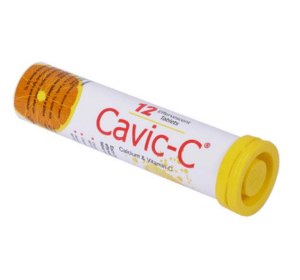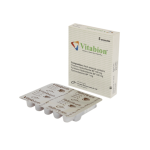Cavic C(Vitamin C & Calcium)

Therapeutic Group: Vitamins and Minerals
Presentation
Cavic-C: Each effervescent tablet contains Calcium lactate gluconate 1000 mg, Calcium carbonate BP 327 mg & Ascorbic acid (Vitamin-C) BP 500 mg.
Description
Calcium is used as a pharmacologic agent in humans almost entirely to remedy deficiency. Adequate calcium in the blood is so vital to a wide variety of bodily functions that our internal biochemistry will not tolerate a deficiency even for short periods.
Vitamin-C is an essential component of the diet as man can not synthesize vitamin-C. It is a very powerful reducing agent. Vitamin-C plays an important part in the response of the body to stress. It is important in the defense against infection.
Indications
Cavic-C is indicated in-
•Increased demand for Calcium and Vitamin-C, e.g. pregnancy, lactation, periods of rapid growth (childhood, adolescence), in old age
•During infectious disease and convalescence
•Treatment of calcium and vitamin-C deficiency
•Osteoporosis
•Premenstrual syndrome
•Postmenopausal problems
•Adjuvant in colds and influenza.
Dosage & Administration
Adults and children above 7 years: 1 effervescent tablet daily
Children 3 to 7 years: 1/2 effervescent tablet daily
Side Effects
In rare cases, mild gastrointestinal disturbances (bloating, diarrhoea) can occur. In predisposed patients prolonged treatment with high doses may promote the formation of calculi in the urinary tract.
Precautions
For patients with mild hypercalciuria (exceeding 300 mg = 7.5 mmol/24 hours), with mild or moderate impairment of renal function or with a history of urinary concrements, monitoring of calcium excretion in the urine is required. If necessary, the dosage should be reduced or therapy should be discontinued. High doses of vitamin-D and derivatives should be avoided during treatment with this preparation unless especially indicated.
Since citrate salts have been reported to increase aluminium absorption, Cavic-C, which contains citric acid as a constituent, should be used with caution in patients with severely impaired renal function, especially those receiving aluminium-containing preparations. The sugar content should be taken into account by diabetic patients.
Use in Pregnancy & Lactation
Epidemiological studies with oral calcium have shown no increase in the teratogenic hazard to the fetus. Although supplemental calcium may be excreted in breast milk, the concentration is unlikely to be sufficient to produce any adverse effect on the neonate.
Vitamin-C may be taken safely during pregnancy and lactation.
Over Dose
Acute overdosage has not been reported. It would be expected to cause gastrointestinal disturbances but not to result in hypercalcemia, except in patients treated with a very high dosage of vitamin-D and derivatives.
Commercial Pack
Cavic-C : Each tube contains 10 effervescent tablets.



